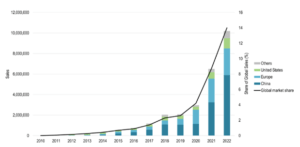By Martin Agyeman KANKAM-BOADU
The transportation sector accounts for a significant portion of global carbon emissions, contributing to environmental degradation and climate change. In response to these challenges, electric vehicles have gained momentum as a sustainable alternative to traditional internal combustion engine vehicles. EVs offer numerous advantages, including zero tailpipe emissions, reduced operating costs, and enhanced energy efficiency. As the world transitions towards a low-carbon economy, understanding the future market prospects of electric vehicles has become imperative.
Current state of the EV market
The EV market has witnessed exponential growth in recent years, driven by advancements in battery technology, declining production costs, and increasing environmental awareness. Between 2021 and 2022 alone there was an increase in sales of about 3.9 million EV cars signifying a percentage increase of 62percent (See Figure 1).
Major automotive manufacturers are investing heavily in electric mobility, launching new models with improved range and performance. Government initiatives, such as subsidies, tax incentives, and regulatory mandates, have accelerated the adoption of EVs in many countries. Despite these advancements, challenges remain, including range anxiety, limited charging infrastructure, and higher upfront costs compared to conventional vehicles.

Key drivers influencing growth
Several factors are driving the growth of the EV market and shaping its future prospects:
- Technological innovations: Ongoing research and development in battery technology are leading to increased energy density, faster charging times, and longer battery life, addressing key barriers to adoption.
- Government policies: Supportive policies and regulations, such as emissions standards, fuel efficiency targets, and investment in charging infrastructure, are incentivizing consumers and businesses to switch to electric vehicles.
- Consumer preferences: Growing environmental consciousness, coupled with improvements in EV design and performance, is driving consumer demand for electric vehicles, especially in urban areas.
- Industry collaboration: Collaboration between automotive manufacturers, technology companies, and energy providers is fostering innovation and accelerating the deployment of electric mobility solutions.
Future market prospects
The future of the EV market looks promising, with several trends indicating sustained growth and expansion. The rising cost of fuel and the high maintenance cost of combustion engine vehicles has made way for customers to consider the cheaper alternative, which are EVs. Below are the major reasons for the promising future market prospects of EVs:
- Market expansion: The EV market is expected to continue growing rapidly, with projections estimating a significant increase in market share over the next decade. As battery costs decline and infrastructure improves, EVs will become increasingly competitive with internal combustion engine vehicles. The continues decline in lithium-ion batteries has made EV cars to become very affordable for customers. (see figure 2- graph showing the decline of lithium battery price between 2013-2023)

- Vehicle Electrification: The electrification of various vehicle segments, including passenger cars, commercial vehicles, and public transportation, will contribute to the widespread adoption of electric mobility solutions. Fleet electrification, in particular, holds immense potential for reducing emissions and operating costs.
- Integration with Renewable Energy: The integration of EVs with renewable energy sources, such as solar and wind power, will enable greater energy independence and sustainability. Smart charging solutions and vehicle-to-grid technologies will optimize energy usage and support grid stability.
- Autonomous Driving: The emergence of autonomous driving technologies will transform the transportation landscape, offering new opportunities for electric and shared mobility services. Electric autonomous vehicles (EAVs) promise to further reduce congestion, emissions, and accidents, enhancing the overall efficiency of transportation systems.
Conclusion
Electric vehicles are poised to revolutionize the transportation sector and play a significant role in achieving global sustainability goals. With advancements in technology, supportive policies, and changing consumer preferences, the future market prospects for EVs are promising. However, addressing remaining challenges, such as charging infrastructure and cost parity, will be essential to unlocking the full potential of electric mobility.
Emerging and low-income countries may also serve as an important new production centers and markets for EVs. The rising cost of fuel, and high maintenance of fuel combustion vehicles has caused consumers in emerging and low-income economies to begin to consider Electric Vehicles as a more affordable alternative. Already, E-Bikes have become a popular trend in emerging economies in Africa, South America and Asia. This shows a great consumer appetite for EVs.
Chinese EV manufacturers should consider looking at expanding production and sales to these markets (Africa, South or Latin America, Middle and south Asia). Furthermore, there is a general momentum of brainstorming among governments in these countries to tilt toward Electric vehicles as a means of public transportation. This has already begun in Africa. In April 2024, Senegal launched a new public transit infrastructure and system in its capital city Dakar. The buses to be used in this new transit system are all EVs. Other governments have plans to emulate Senegal’s trajectory.
Lastly by embracing innovation, collaboration, and strategic planning, stakeholders can capitalize on the opportunities presented by electric vehicles and shape a more sustainable future for transportation.
>>>The writer has a PhD in Supply Chain & Operations Management. He can be reached via [email protected]
References
- Global Electric Vehicles Sales, 2010-2022 | The Geography of Transport Systems. (2023, May 29). The Geography of Transport Systems | the Spatial Organization of Transportation and Mobility. https://transportgeography.org/contents/chapter4/transportation-sustainability-decarbonization/global-electric-vehicles-sales/
- Policies to promote electric vehicle deployment – Global EV Outlook 2021 – Analysis – IEA. (n.d.). IEA. https://www.iea.org/reports/global-ev-outlook-2021/policies-to-promote-electric-vehicle-deployment
- Trends in electric cars – Global EV Outlook 2024 – Analysis – IEA. (n.d.). IEA. https://www.iea.org/reports/global-ev-outlook-2024/trends-in-electric-cars
- (n.d.). Electric vehicles – Worldwide | Statista market forecast. https://www.statista.com/outlook/mmo/electric-vehicles/worldwide
- Bloomberg – Are you a robot? (2024, January 9). https://www.bloomberg.com/news/newsletters/2024-01-09/electric-vehicle-market-looks-headed-for-22-growth-this-year
- Peng, R., Tang, J. H. C. G., Yang, X., Meng, M., Zhang, J., & Zhuge, C. (2024). Investigating the factors influencing the electric vehicle market share: A comparative study of the European Union and United States. Applied Energy, 355, 122327. https://doi.org/10.1016/j.apenergy.2023.122327
- Olano, M. V. (2022, February 18). Chart: Global EV sales more than doubled in 2021. Canary Media. https://www.canarymedia.com/articles/electric-vehicles/chart-global-ev-sales-more-than-doubled-in-2021










